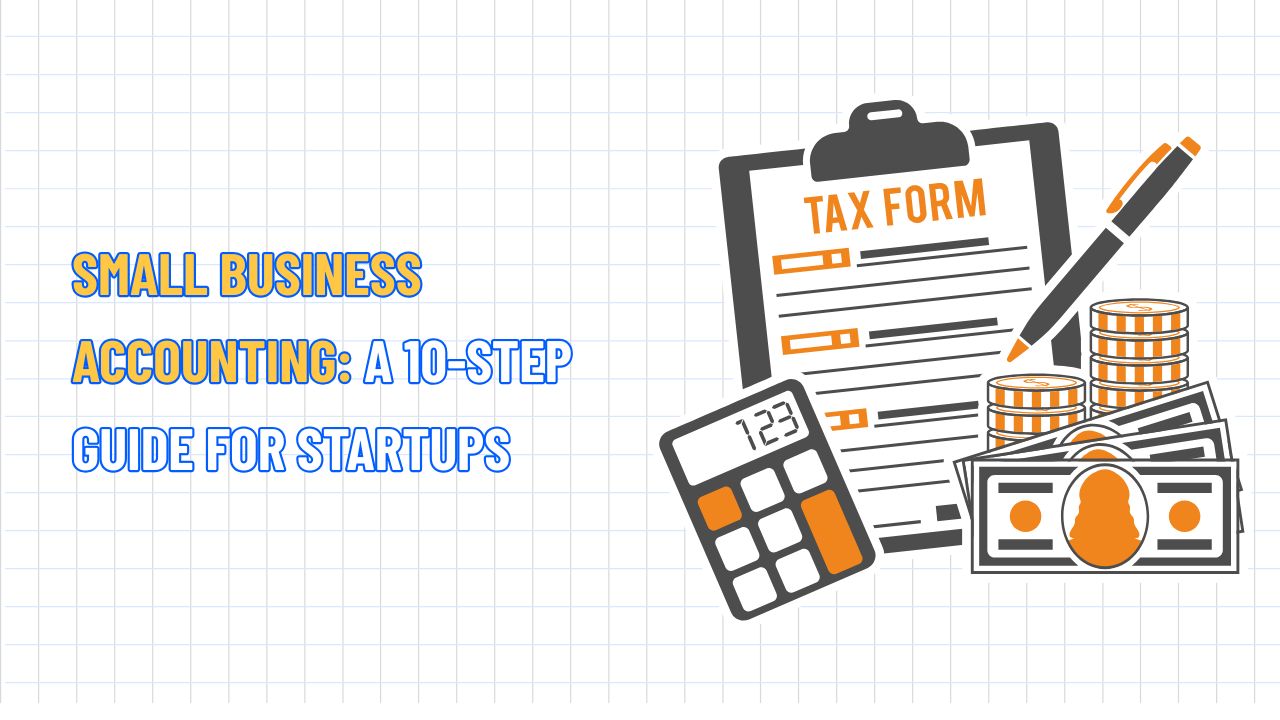Small Business Finances Management from A-Z You Can't Miss
Table of Contents Hide
For small businesses, mastering small business finances is the key to unlocking sustainable success. In the article below, NextSky dives into practical strategies and effective financial management methods to help you build a solid foundation for robust business growth.

TOP 7 small business finances you can't miss
1. Mastering cash flow
Small business financial management starts with understanding and controlling your cash flow. Here are key cash flow management strategies for small businesses you shouldn't overlook:
- Create cash flow reports and forecasts: Track income and expenses regularly to monitor cash flow and predict future capital needs. Don't forget to use tools like QuickBooks or Xero for automation, especially if you're a startup just getting off the ground.
- Monitor frequently: For new businesses or those heavily reliant on cash, like retail or restaurants, check cash flow weekly or daily to spot trends and address issues early.
- Optimize payment terms: Speed up incoming cash by shortening customer payment terms to 7–14 days. You can also consider offering a 2% payment discount within 10 days to encourage faster payouts.
- Vet customer credit: Use services like Experian or Creditsafe to evaluate new customers before extending credit. This minimizes the risk of late or non-payments.
- Build an emergency fund: Set aside 3–6 months of operating expenses in a savings account to handle unexpected costs like equipment repairs or slow revenue periods.
Expert tip: For seasonal businesses, forecast cash flow for 12 months to anticipate low-revenue periods and plan accordingly. For example, an e-commerce store focused on holidays should save excess funds from peak seasons to cover off-peak months.
Read more: What is A Small Business? A Comprehensive Guide to Definition
2. Small business accounting basics
Effective small business financial management requires a solid grasp of basic accounting principles to stay compliant, optimize reporting, and simplify tax season.
- Open a business bank account: Separating personal and company finances ensures transparent cash flow tracking, easier bookkeeping, and greater credibility with partners. Prioritize banks with low fees, flexible online services, and automated accounting integrations.
- Choose cloud-based accounting software: Platforms like Xero, QuickBooks, or FreshBooks simplify invoicing, expense tracking, and reporting.
- Understand key terms:
- Bookkeeping: Daily tasks like recording expenses, issuing invoices, and tracking payments.
- Annual financial statements: For limited companies, submit financial reports including balance sheets and profit-and-loss statements. Sole proprietors should maintain these for internal purposes.
- Taxes: Limited companies pay corporation tax (19% in the UK for 2023), while sole proprietors self-assess and pay income tax. If annual revenue exceeds £85,000, 20% VAT applies.
- PAYE: If you have employees, deduct income tax and national insurance contributions monthly.
- Consider hiring an accountant: As your business grows, an accountant can handle complex tasks like tax filing, VAT reporting, and financial audits, saving time and reducing errors.
Expert tip: Reconcile accounts monthly to catch discrepancies early. This involves comparing bank statements with accounting records to ensure accuracy.
3. Financial planning and forecasting
A well-crafted financial plan is a roadmap, helping your business look beyond short-term numbers.
Core financial documents
- Balance sheet: Provides a snapshot of assets, liabilities, and equity. A healthy balance sheet signals strong financial health and efficient operations.
- Profit-and-loss statement: Summarizes revenue, expenses, and net profit over a period. It's a core tool for evaluating business performance, spotting cost-saving opportunities, and boosting profitability.
- Cash flow statement: Tracks cash inflows and outflows to keep your business proactive amid financial fluctuations.
- Break-even analysis: Indicates the sales volume needed to cover costs. For example, with $10,000 in fixed costs and $50 profit per product, you'd need to sell 200 units to break even.
Smart financial forecasting
- Develop three optimistic, pessimistic, and realistic scenarios for contingency planning.
- Use real data and market trends to refine forecasts, factoring in seasonality, customer behavior, or macroeconomic factors.
- Review and update quarterly to reflect actual performance and adjust growth targets promptly.
Read more: TOP 15 Detailed Small Business Tips to Help You Succeed
4. Managing small business debt
Debt can be a lever for growth, but without tight management, it can become a burden that spirals out of control. Here are principles to help small businesses handle debt effectively:
- Build a buffer fund: Save a portion of monthly profits to cover unexpected expenses, reducing reliance on loans or credit cards.
- Cut unnecessary costs: Eliminate non-essential expenses, like premium subscriptions or unused office space, to free up cash for debt repayment.
- Refinance high-interest loans: If saddled with high rates, negotiate or switch to lower-interest options to ease monthly payments.
- Negotiate with suppliers: Request discounts or extended payment terms to improve cash flow. For instance, bulk orders might snag 5–10% off.
- Boost revenue: Drive sales through promotions, cross-selling products, or expanding into new markets.
5. Exploring business financing options
Understanding funding sources for small businesses is foundational to making wise financial decisions. Here's an overview of common financing types to consider.
Debt financing
- Bank loans: Ideal for established businesses with solid credit history. Before signing, compare interest rates, terms, and conditions to find the best fit.
- Invoice financing: Get immediate cash by selling unpaid invoices. It's an efficient way to maintain cash flow when customers have long payment cycles.
- Business credit cards: Handy for short-term needs, but avoid carrying balances due to high interest.
- Short-term loans: Provide quick capital for emergencies, though high borrowing costs require careful consideration.
Equity financing
- Venture capital is for high-growth startups in exchange for sharing ownership and profits.
- Crowdfunding: Platforms like Kickstarter let you raise funds from the public in return for rewards or equity.
- Angel investors: Wealthy individuals ready to invest capital and offer guidance for steady growth.
- Grants: Government or financial organization programs for small businesses can provide non-repayable funding. However, they often have strict eligibility criteria, so research via the U.S. Small Business Administration (SBA) or UK business support tools is necessary.
Expert tip: For e-commerce businesses, invoice financing can unlock cash tied up in unpaid orders, allowing faster reinvestment in inventory or marketing.
Read more: Budgeting for Small Business: A Step-by-Step Guide to Success
6. Practical tips for small business financial management
Here are smart financial tips to help small businesses maintain stability and aim for sustainable growth:
- Pay yourself a salary: Don't overlook fair compensation for your efforts. A steady personal income keeps motivation high and prevents burnout or financial strain.
- Track ROI: Measure every expense by its return. A $1,000 ad campaign generating $5,000 in revenue justifies the spend.
- Break down tax payments: Divide quarterly taxes into monthly contributions to avoid cash flow shortfalls.
- Automate processes: Use tools like Zapier or Shopify apps to track invoicing and expenses, saving time and minimizing errors.
- Stay informed: Regularly read industry blogs, attend online webinars, or consult financial advisors for the latest business finance advice.
7. Leveraging technology for financial success
For e-commerce businesses, technology can streamline financial management. Here's why integrating financial tools into your workflow matters:
- Use Shopify apps: Leverage integrations like QuickBooks Sync or Bench directly with Shopify to track sales, expenses, and taxes in real time, giving accurate, timely financial insights.
- Optimize speed: Build a fast-loading, SEO-friendly site like those designed with NextSky's Agile theme to reduce cart abandonment and significantly boost revenue.
- Integrate APIs: Automate financial reporting by connecting your e-commerce platform to accounting software via APIs for seamless data flow.
Expert tip: A well-designed e-commerce site can increase conversion rates by up to 20%, directly impacting your cash flow. Invest in tools that enhance user experience and financial tracking.
Why choose Nextsky for your e-commerce financial success?
While this guide focuses on managing your business finances, the right technology can amplify your e-commerce success. Nextsky’s Shopify themes are designed to optimize store performance, provide a smooth user experience, increase sales, and are SEO-friendly. Some of the featured themes include:
- Glozin: Modern design, suitable for fashion and lifestyle stores, optimized for loading speed and customer experience.
- Agile: Flexible, customizable, great for multi-category stores.
- Umino: Optimized for tech and digital product ecommerce, SEO-friendly.
By combining these themes with financial tools like QuickBooks or Shopify Capital, you can simplify the management of revenue, expenses, and cash flow, so you can focus on growing and expanding your business.
Mastering small business finances is an essential launchpad for sustainable growth. With the insights from NextSky, you'll build a rock-solid foundation to skyrocket revenue and elevate customer experiences.










